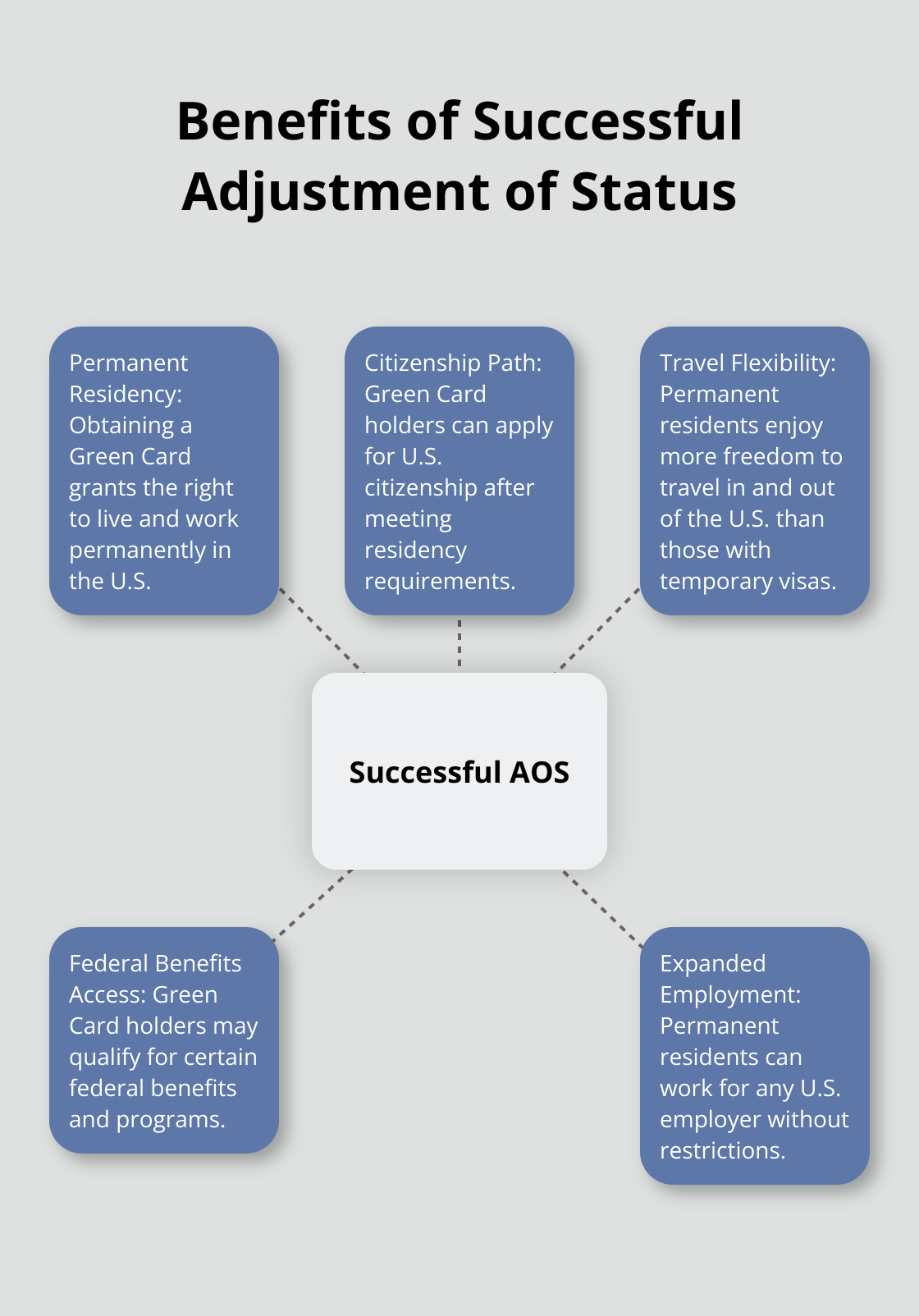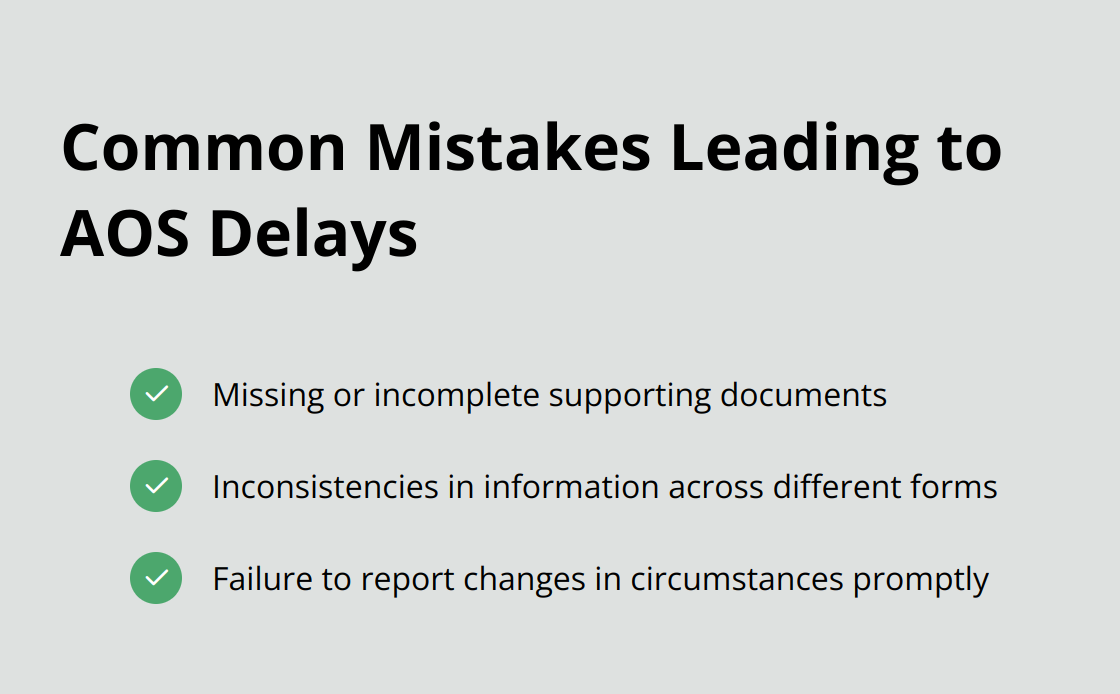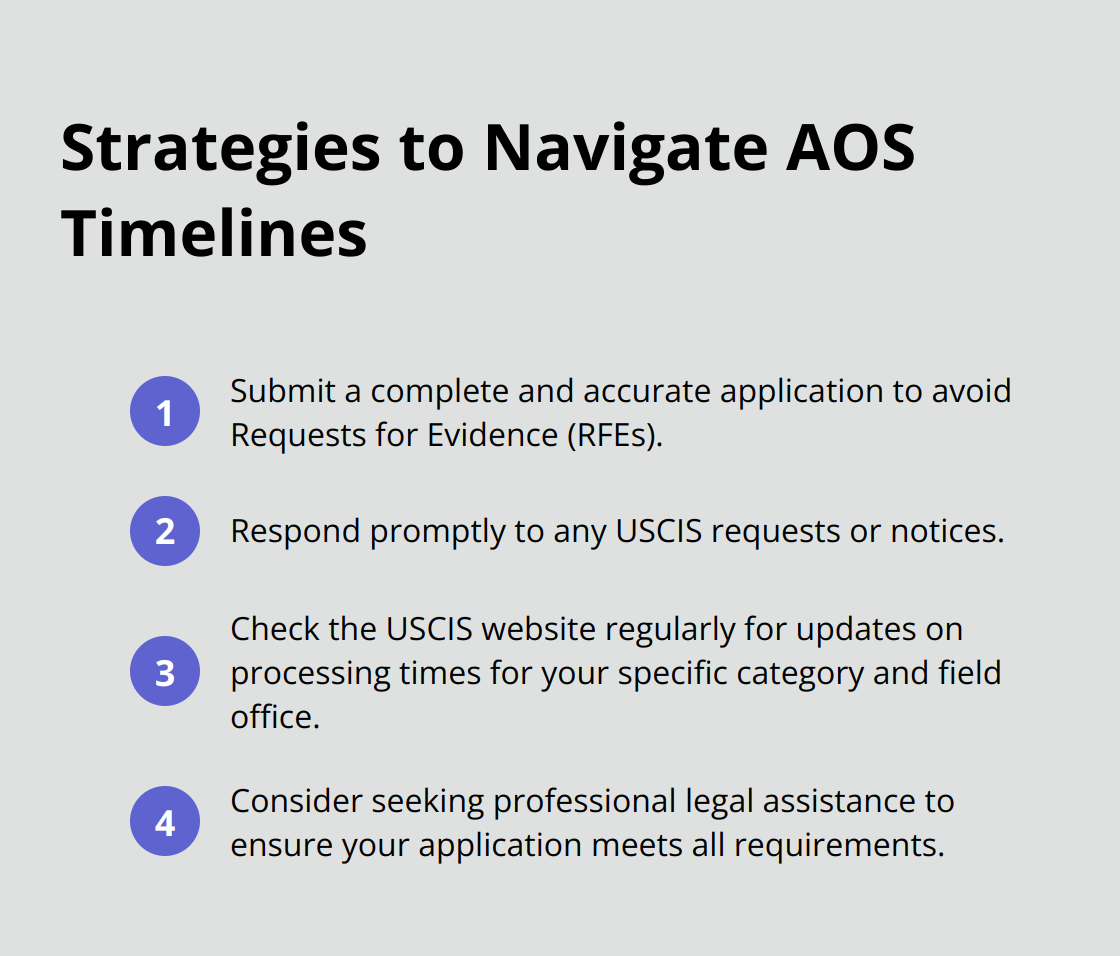
How Long Does Adjustment of Status Take in 2025?
At Law Offices of Jeffrey A. Thompson, we understand the importance of knowing how long the Adjustment of Status process takes in 2025. This critical step in the immigration journey can be complex and time-consuming.
In this post, we’ll explore the factors affecting processing times and provide up-to-date information on current timelines. We’ll also share practical tips to help you navigate this process more efficiently.
What is Adjustment of Status?
Definition and Purpose
Adjustment of Status (AOS) is a key process in U.S. immigration law. It allows eligible individuals to apply for lawful permanent resident status (also known as applying for a Green Card) without leaving the United States. AOS transforms a temporary immigration status into permanent residency.
Eligibility Criteria
Not everyone qualifies for AOS. Applicants must meet specific requirements:
- Physical presence in the U.S.
- Legal entry into the country
- Immediate availability of an immigrant visa
- Admissibility to the U.S.
Common eligible categories include family-sponsored immigrants, employment-based immigrants, and diversity visa winners. Each case has unique aspects, and eligibility can be complex.
Application Process
The AOS process typically requires filing Form I-485 with U.S. Citizenship and Immigration Services (USCIS). This form often needs supporting documents, such as:
- Eligibility proof
- Medical examination results
- Affidavit of support (if applicable)
- Passport-style photographs
After submission, applicants undergo biometrics screening and may need to attend an interview. The entire process can take several months to over a year (depending on various factors).
Benefits of Successful AOS
A successful AOS application offers significant advantages:
- Permanent Residency: Obtaining a Green Card grants the right to live and work permanently in the U.S.
- Citizenship Path: Green Card holders can apply for U.S. citizenship after meeting residency requirements.
- Travel Flexibility: Permanent residents enjoy more freedom to travel in and out of the U.S. than those with temporary visas.
- Federal Benefits Access: Green Card holders may qualify for certain federal benefits and programs.
- Expanded Employment: Permanent residents can work for any U.S. employer without restrictions.
Understanding AOS intricacies is essential for a successful application. While this overview provides a foundation, each case has its nuances. For personalized guidance tailored to your specific situation, consulting with experienced immigration attorneys can prove invaluable.

The next section will explore the factors that affect AOS processing times, shedding light on why some applications take longer than others.
What Impacts AOS Processing Times?
USCIS Workload and Policy Changes
The U.S. Citizenship and Immigration Services (USCIS) workload significantly affects processing times. This report contains the number of forms received, processed, approved, denied, and pending by month, along with the average processing time and the number of applications. As of 2025, USCIS continues to face substantial backlogs, partly due to the lingering effects of the COVID-19 pandemic and policy shifts. The removal of the COVID-19 vaccination requirement for adjustment applications on January 20, 2025, has streamlined some processes. However, the overall volume of applications remains high, which impacts processing times across all categories.
Immigration Category and Visa Availability
The specific immigration category under which an applicant files for AOS significantly impacts processing times. Family-based applications, particularly those for immediate relatives of U.S. citizens, often move faster than employment-based categories. For example, in 2025, family-based AOS applications in Dallas average a processing time of 15 months (with 80% of cases completed within this timeframe).
Visa availability is another critical factor. Some categories, especially certain employment-based visas, have annual caps that can create long waiting periods. Applicants must check the Visa Bulletin regularly to understand current wait times for their specific category and country of origin.
Application Completeness and Accuracy
The thoroughness and accuracy of an AOS application directly affect its processing time. Incomplete or inaccurate submissions often result in Requests for Evidence (RFEs), which can add months to the process.
Common mistakes that lead to delays include:
- Missing or incomplete supporting documents
- Inconsistencies in information across different forms
- Failure to report changes in circumstances promptly
Applicants should create a comprehensive checklist of required documents and review all forms multiple times before submission. Prompt responses to any USCIS requests are also essential in keeping the process moving.

Background Checks and Security Clearances
Every AOS applicant undergoes background checks and security clearances, which can vary in duration. Factors such as an applicant’s country of origin, travel history, and personal background can influence the length and complexity of these checks. While most security clearances complete relatively quickly, some cases may require additional administrative processing, potentially extending the overall timeline.
The next section will explore the current processing times for different AOS categories in 2025, providing a clearer picture of what applicants can expect in the current immigration landscape.
AOS Processing Times in 2025: What to Expect
Family-Based AOS Timelines
Family-based Adjustment of Status (AOS) applications typically process faster than other categories. In 2025, immediate relatives of U.S. citizens (spouses, unmarried children under 21, and parents) face the shortest wait times. The U.S. Citizenship and Immigration Services (USCIS) provides historical national median processing times for various forms, including those for Fiscal Year 2020 to 2025 (up to April 30, 2025).
Family preference categories experience longer waits. Married children of U.S. citizens (F3 category) and siblings of U.S. citizens (F4 category) may wait 18 to 24 months for AOS processing.
Employment-Based AOS Durations
Employment-based AOS applications usually require more time to process. In 2025, EB-1 category (priority workers) applications take about 12 to 18 months. EB-2 (professionals with advanced degrees) and EB-3 (skilled workers and professionals) categories face longer waits, averaging 18 to 24 months.
These timelines can extend significantly for applicants from countries with high demand (such as India and China) due to per-country visa limits.
Regional Processing Time Variations
AOS processing times vary considerably depending on the USCIS field office handling the application. The New York City field office reports longer processing times compared to less busy offices in smaller cities.
As of 2025, the Dallas field office processes family-based AOS applications in an average of 15 months, while the Los Angeles office takes about 17 months for similar cases.
Recent Policy Changes and Their Impact
Recent policy changes have influenced AOS processing times. The removal of the COVID-19 vaccination requirement for adjustment applications on January 20, 2025, has expedited some cases slightly. USCIS has also implemented new technologies to streamline application review, potentially reducing processing times for certain categories.
However, the ongoing high volume of applications continues to challenge USCIS capacity. The agency has responded by reallocating resources and hiring additional staff, but the effects of these measures are yet to fully materialize.
Strategies to Navigate AOS Timelines
To navigate AOS timelines effectively:
- Submit a complete and accurate application to avoid Requests for Evidence (RFEs).
- Respond promptly to any USCIS requests or notices.
- Check the USCIS website regularly for updates on processing times for your specific category and field office.
- Consider seeking professional legal assistance to ensure your application meets all requirements.
The Law Offices of Jeffrey A. Thompson can provide expert guidance throughout the AOS process, helping you understand current timelines and navigate potential challenges.

Final Thoughts
The Adjustment of Status (AOS) process in 2025 demands patience and meticulous attention to detail. USCIS workload, visa availability, application accuracy, and background checks all influence how long Adjustment of Status takes in 2025. Family-based applications often move faster, while employment-based categories typically face longer waits due to annual caps and country-specific limitations.
Applicants can potentially speed up the AOS process by submitting complete applications, responding quickly to USCIS requests, and staying informed about current processing times. The complexities of immigration law and potential consequences of errors make professional legal assistance highly valuable. Law Offices of Jeffrey A. Thompson specializes in guiding clients through immigration processes, including AOS.
Our expertise in family law, personal injury, and immigration law allows us to provide comprehensive support tailored to your unique situation. A well-prepared application and expert guidance can make a significant difference in your immigration journey. You can navigate the AOS process more effectively and move closer to achieving your goal of permanent residency in the United States.


